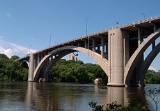
Franklin Avenue Bridge
Encyclopedia
The Franklin Avenue Bridge, officially the F.W. Cappelen Memorial Bridge, carries Franklin Avenue over the Mississippi River
in Minneapolis, Minnesota
. It was designed by Frederick William Cappelen, assisted by Kristoffer Olsen Oustad
, both of whom were among four important Norwegian
-American
engineer
s working in the region at the time. The reinforced-concrete
open-spandrel
arch
ed structure was completed in 1923. The bridge's overall length is 1054.7 feet (321.47 m), with a central span of 400 feet (122 m). It was added to the National Register of Historic Places
in 1989 along with several other area bridges as part of a multiple-property submission.
The current bridge replaces one built in 1889 and its pilings and foundation can still be seen to the south of the current bridge. During planning of this original bridge there was consideration and debate concerning its possible interference with river navigation.
In the late 1990s, there was an easy way to climb the arches under the bridge and walk along a path that spanned the entire way across the river. Vagrants, graffiti artists, and locals would frequent this area at all times of the day.
Mississippi River
The Mississippi River is the largest river system in North America. Flowing entirely in the United States, this river rises in western Minnesota and meanders slowly southwards for to the Mississippi River Delta at the Gulf of Mexico. With its many tributaries, the Mississippi's watershed drains...
in Minneapolis, Minnesota
Minneapolis, Minnesota
Minneapolis , nicknamed "City of Lakes" and the "Mill City," is the county seat of Hennepin County, the largest city in the U.S. state of Minnesota, and the 48th largest in the United States...
. It was designed by Frederick William Cappelen, assisted by Kristoffer Olsen Oustad
Kristoffer Olsen Oustad
Kristoffer Olsen Oustad was a Norwegian-American engineer who designed major structures in the United States. Often working together with three other Norwegian-American engineers Kristoffer Olsen Oustad (Died February 13, 1943) was a Norwegian-American engineer who designed major structures in...
, both of whom were among four important Norwegian
Norway
Norway , officially the Kingdom of Norway, is a Nordic unitary constitutional monarchy whose territory comprises the western portion of the Scandinavian Peninsula, Jan Mayen, and the Arctic archipelago of Svalbard and Bouvet Island. Norway has a total area of and a population of about 4.9 million...
-American
United States
The United States of America is a federal constitutional republic comprising fifty states and a federal district...
engineer
Engineer
An engineer is a professional practitioner of engineering, concerned with applying scientific knowledge, mathematics and ingenuity to develop solutions for technical problems. Engineers design materials, structures, machines and systems while considering the limitations imposed by practicality,...
s working in the region at the time. The reinforced-concrete
Reinforced concrete
Reinforced concrete is concrete in which reinforcement bars , reinforcement grids, plates or fibers have been incorporated to strengthen the concrete in tension. It was invented by French gardener Joseph Monier in 1849 and patented in 1867. The term Ferro Concrete refers only to concrete that is...
open-spandrel
Spandrel
A spandrel, less often spandril or splaundrel, is the space between two arches or between an arch and a rectangular enclosure....
arch
Arch
An arch is a structure that spans a space and supports a load. Arches appeared as early as the 2nd millennium BC in Mesopotamian brick architecture and their systematic use started with the Ancient Romans who were the first to apply the technique to a wide range of structures.-Technical aspects:The...
ed structure was completed in 1923. The bridge's overall length is 1054.7 feet (321.47 m), with a central span of 400 feet (122 m). It was added to the National Register of Historic Places
National Register of Historic Places
The National Register of Historic Places is the United States government's official list of districts, sites, buildings, structures, and objects deemed worthy of preservation...
in 1989 along with several other area bridges as part of a multiple-property submission.
The current bridge replaces one built in 1889 and its pilings and foundation can still be seen to the south of the current bridge. During planning of this original bridge there was consideration and debate concerning its possible interference with river navigation.
In the late 1990s, there was an easy way to climb the arches under the bridge and walk along a path that spanned the entire way across the river. Vagrants, graffiti artists, and locals would frequent this area at all times of the day.

